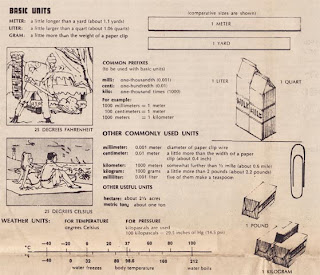In 1973 Great Britain joined the European Community, a precursor to the EU, and all hell broke loose. Specifically, a slow kind of arithmetic hell broke gradually loose as it dawned on normal British people that the weights, measures and currency they had adhered to for many hundreds of years were now deigned stupefyingly nonsensical by their new Euro cousins, and that in order to enjoy all the Continent had to offer in terms of armloads of cheap wine and pastry procured by day trippers to Calais, it would be necessary to convert to the damnable Metric system.
Naturally, this impertinence to the beloved Imperial system was resisted vehemently in an attempt to cling to the very stuff that made British people British: namely, their bloody-minded oddness. Why describe a person’s weight in kilograms when you can use stones? (1 stone = 14 lbs. 1 lb = 16 ozs.) What the heck is a centimeter and aren’t inches and feet obviously better units of measurement for building things? (1 foot = 12 inches.) What does 18 degrees feel like, and would you have to don a cardigan? (Freezing = 32 degrees.) You could hold a pint of milk in your hand, but could you carry a litre? How many kilometers to the litre can you get for 60 pence? Shillings, guineas, pounds and pennies all morphed into new coins based on multiples of ten instead of 12 and 20. It was madness. CLICK HERE.
Thus is was that the government had to crack the whip and demand that for a period of time, both Imperial and Metric units had to be displayed on most everything you could buy. If you fell afoul of this law, a Belgian woman would be deployed to your place of business to give you a good seeing-to. Some things made the transition and some didn’t. You’d still order a pint of beer in a pub, though what you’d actually get would be whatever that is in whatever liquid is measured in in metric. Just thinking about it makes you drunk.
All of which is to explain why this appalling recipe from Dougal’s Cook Book has both Imperial and Metric units: it was published in 1973. It’s a recipe particularly unsuited for children’s tastes involving a raw cabbage and a snail. Have you ever smelled raw cabbage? I need say no more.
If you’re not British, you’ll also be wondering what that strange beast is with a chef’s toque on in the cover photo. That’s Dougal, star of a children’s television show that aired between 1965 – 1977 called The Magic Roundabout. The single most distinguishing thing about this show is that it was obviously all about the consumption of massive amounts of drugs and came from France. Dougal was fond of sucking on sugar cubes, after which he’d race around at top speed. It was a show for and about hipster freaks, and as such was beloved by a generation of innocent children who as adults cling to the memory of it with a nostalgia as passionate as that for the good old Imperial system.
Check it out HERE.
The Magic Roundabout has attained such an iconic place in British culture that an actual traffic circle in Swindon is named the Magic Roundabout, mostly because it is so unnecessarily complex that instead of meeting certain death when venturing into it, people tend to emerge dazed but unscathed, because they’d had to drive so slowly to figure it out. It is a feat of post-Imperial engineering that appears to have been designed especially to confound our European visitors as an exquisite revenge, except the joke’s on the poor people of Swindon, because no-one ever goes there.
Dougal’s Cook Book, Hamlyn, 1973



